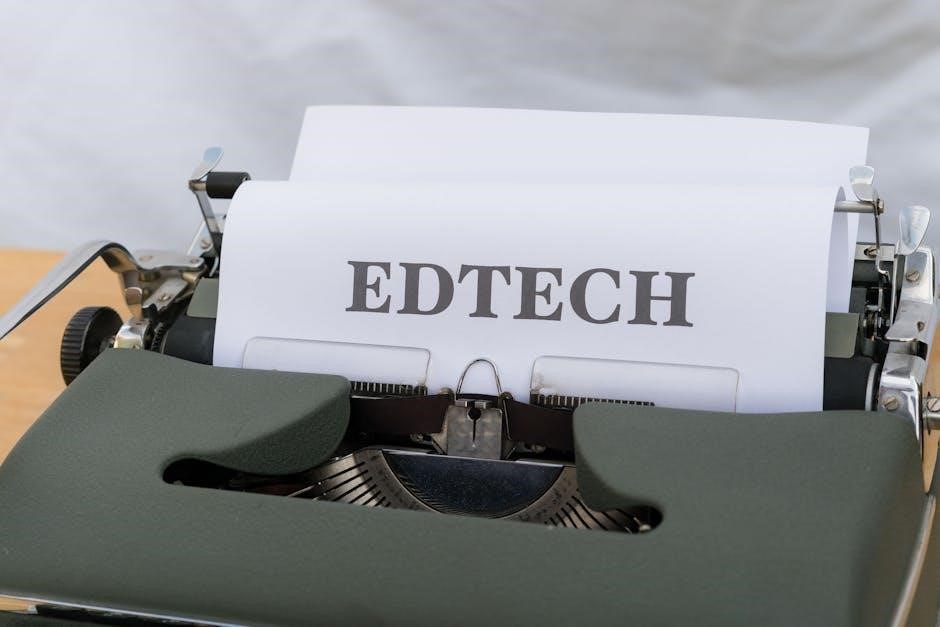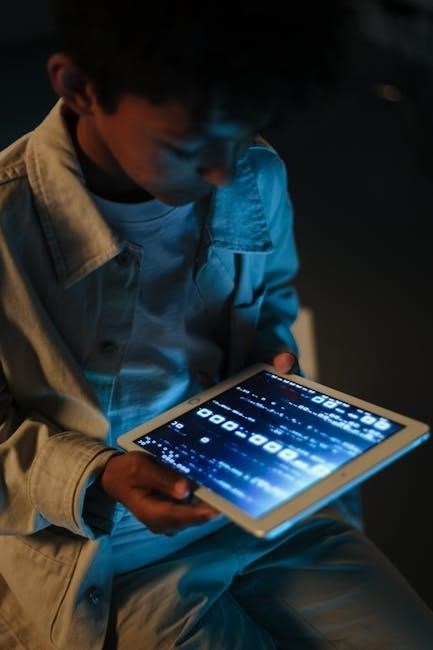Instructional technology represents a transformative force‚ integrating tools and pedagogical strategies to enhance learning experiences. It encompasses design‚ development‚ utilization‚ management‚ and evaluation of processes and resources for learning‚ creating meaningful experts in education.
Definition of Instructional Technology
Instructional Technology‚ as defined by Seels and Richey (1994)‚ represents the theory and practice of design‚ development‚ utilization‚ management‚ and evaluation of processes and resources for learning. It employs a combination of technologies‚ media‚ and techniques to create‚ support‚ and deliver instructional programs. It’s a discipline area and an integral part of virtually every area of study and learning faced by students of all ages.
Instructional technology’s main goal is to enhance both teaching and learning processes. It builds a learning system with feedback‚ sensitive to individual experiences‚ improving effectiveness over time. The focus is on incorporating technology and media into the educational repertoire‚ guiding students in their use as teaching tools;

The Association for Educational Communications and Technology (AECT) further elaborates on this definition‚ emphasizing its role as a means of transmitting knowledge and skills to adult learners. It leverages electronic devices to ease the teaching-learning process‚ ultimately fostering a more meaningful and impactful educational experience for all.
The Role of Media in Instructional Technology
Media plays a crucial role in instructional technology‚ serving as the modes of communication through which teaching takes place. This includes everything from face-to-face interaction and radio lessons to interactive learning via the Internet. Media encompasses a wide range of formats‚ integrated into classroom instruction using models like the ASSURE model of lesson planning.
Modern information technologies serve as instructional media‚ appealing due to their capacity to engage learners. The appropriate selection of media is essential for increased learning and cost-effectiveness. Different media categories‚ such as text‚ audio‚ visuals‚ animations‚ and real objects‚ relate to learning differently and affect learner motivation.
Furthermore‚ social media technologies allow instructors to demonstrate how professional networks function on a technical level. This is an instructional strategy where the majority of initial learning occurs before practical application. Media‚ therefore‚ bridges the gap between theory and practice‚ providing students with the necessary tools for success.
Instructional Technology vs. Educational Technology
While often used interchangeably‚ instructional technology and educational technology possess distinct focuses; Instructional technology centers on enhancing both teaching and learning processes through the strategic use of various technologies‚ media‚ and techniques. It emphasizes the design‚ development‚ utilization‚ and evaluation of resources to optimize learning outcomes for students of all ages.
Educational technology‚ conversely‚ primarily aims at technological literacy for everyone. It encompasses a broader scope‚ including tools and techniques that facilitate teaching and learning‚ preparing individuals to navigate a technology-driven world. Educational technology focuses on the integration of technology to meet the learning needs of all students.
In essence‚ instructional technology is a subset of educational technology. While educational technology aims for widespread technological competence‚ instructional technology focuses on the specific application of technology to improve the effectiveness of instruction and learning within formal educational settings.
Key Components of Instructional Technology
Instructional technology comprises several key components that work together to create effective learning experiences. A core component is the systematic design of instruction‚ employing models like ASSURE to analyze learners‚ set objectives‚ select methods‚ utilize media‚ require participation‚ and evaluate outcomes. This design process ensures alignment with learning goals and learner needs.
The selection and integration of appropriate media are also crucial. This involves choosing from a range of formats‚ including text‚ audio‚ visuals‚ animations‚ and real objects‚ to best convey information and engage learners. Effective utilization of these media requires careful consideration of their impact on learner motivation and accessibility.
Furthermore‚ instructional technology emphasizes evaluation and continuous improvement. Feedback mechanisms‚ sensitive to individual learning experiences‚ are built into the system to monitor progress and refine instructional strategies. This iterative process ensures that the technology enhances learning outcomes and adapts to evolving needs.
Examples of Instructional Media
Instructional media encompasses a wide range of tools and resources used to facilitate teaching and learning. Traditional examples include textbooks‚ chalkboards‚ and overhead projectors‚ which have long been staples in education. These provide a foundation for delivering content and engaging students in a classroom setting.

Modern instructional media extends to digital platforms and technologies. Presentation software like PowerPoint and Keynote allows instructors to create visually engaging lectures. Learning Management Systems (LMS) such as Moodle or Canvas provide online environments for course delivery‚ assessment‚ and communication. Interactive simulations and educational games offer immersive learning experiences‚ allowing students to apply knowledge in simulated scenarios.
Furthermore‚ multimedia resources like videos‚ podcasts‚ and interactive websites provide diverse avenues for accessing information and engaging with course material. Social media platforms can also be leveraged for educational purposes‚ fostering collaboration and knowledge sharing among learners. These examples illustrate the breadth and adaptability of instructional media in contemporary education.
Selecting Appropriate Instructional Media
Choosing the right instructional media is crucial for effective teaching and learning. The selection process should start with clearly defined learning objectives. What specific knowledge or skills should students acquire? The chosen media should directly support these objectives‚ ensuring alignment between content and delivery method.
Consider the characteristics of your learners. What are their learning styles‚ prior knowledge‚ and preferences? Some students may thrive with visual aids‚ while others prefer auditory learning or hands-on activities. Adapting media choices to cater to diverse learning needs can enhance engagement and comprehension.
Practical factors also play a significant role. Evaluate the availability of resources‚ including technology infrastructure‚ budget constraints‚ and technical support. The media should be accessible and user-friendly for both instructors and students. Furthermore‚ consider the context of the learning environment. Will the media be used in a classroom‚ online‚ or in a blended setting? The chosen media should be appropriate for the learning environment‚ ensuring seamless integration and optimal learning outcomes.
The ASSURE Model in Instructional Design
The ASSURE model provides a systematic framework for instructional design‚ ensuring effective integration of technology and media. ASSURE is an acronym representing six key stages: Analyze learners‚ State objectives‚ Select methods‚ media‚ and materials‚ Utilize media and materials‚ Require learner participation‚ and Evaluate and revise.
The first step‚ Analyze learners‚ involves understanding the learners’ characteristics‚ including prior knowledge‚ learning styles‚ and motivation. This analysis informs the subsequent design decisions. Next‚ State objectives clearly defines what learners should be able to do upon completion of the instruction. Objectives should be specific‚ measurable‚ achievable‚ relevant‚ and time-bound (SMART).

The third stage‚ Select methods‚ media‚ and materials‚ involves choosing appropriate instructional strategies and resources to support the learning objectives. This includes selecting relevant technologies‚ media formats‚ and learning materials. Utilize media and materials focuses on effectively implementing the chosen resources in the learning environment.
Require learner participation emphasizes active learning strategies to engage students and promote deeper understanding. Finally‚ Evaluate and revise involves assessing the effectiveness of the instruction and making necessary adjustments for future iterations‚ ensuring continuous improvement.
Impact of Media on Learner Motivation
Media plays a significant role in influencing learner motivation. Well-designed instructional media can capture attention‚ stimulate interest‚ and foster a positive learning environment. The appeal of modern informational technologies lies in their ability to enhance engagement through interactive and immersive experiences. Visual media‚ in particular‚ can be highly effective in conveying complex concepts and making learning more accessible.

Different media categories‚ such as text‚ audio‚ visuals‚ animations‚ and real objects‚ can affect a learner’s motivation in various ways. For instance‚ animations and interactive simulations can increase engagement and promote deeper understanding. Social media technologies can also be leveraged to create collaborative learning environments and foster a sense of community‚ thereby increasing motivation.
Moreover‚ the use of relevant and engaging media can help learners connect with the content on a personal level‚ making it more meaningful and memorable. However‚ it is crucial to select media that aligns with the learning objectives and caters to the learners’ needs and preferences. Poorly designed or irrelevant media can have the opposite effect‚ leading to disengagement and decreased motivation. Therefore‚ careful consideration of the media’s impact on learner motivation is essential for effective instructional design.
Technology Integration in Education
Technology integration in education involves seamlessly incorporating technology tools and resources into the curriculum to enhance teaching and learning. It goes beyond simply using technology for its own sake and focuses on leveraging its potential to improve student outcomes. Effective technology integration requires careful planning‚ thoughtful implementation‚ and ongoing evaluation.
The goal of technology integration is to create a learning environment where technology becomes an integral part of the instructional process. This can involve using technology to deliver content‚ facilitate collaboration‚ provide personalized learning experiences‚ and assess student progress. Social media technologies can also be integrated to foster professional networks.
Successful technology integration also involves addressing the challenges and ensuring equitable access for all students. Educators need to be trained in the effective use of technology and provided with the necessary resources and support. Furthermore‚ it is important to consider the ethical and social implications of technology use in the classroom. By addressing these issues‚ educators can create a technology-rich learning environment that promotes student engagement‚ achievement‚ and digital literacy.
Trends in Instructional Technology: AI and AR
Artificial intelligence (AI) and augmented reality (AR) are emerging as transformative trends in instructional technology‚ promising to revolutionize the way students learn and educators teach. AI offers the potential to personalize learning experiences by adapting to individual student needs and providing customized feedback. AI-powered systems can analyze student data to identify learning gaps and recommend appropriate resources‚ ultimately enhancing learning outcomes.
Augmented reality (AR) overlays digital information onto the real world‚ creating immersive and interactive learning experiences. AR applications can bring abstract concepts to life‚ allowing students to visualize and manipulate objects in a virtual environment. This can be particularly beneficial in subjects such as science‚ mathematics‚ and engineering‚ where hands-on learning is essential.
The integration of AI and AR into education requires careful consideration of pedagogical principles and ethical implications. Educators need to be trained in the effective use of these technologies and provided with the necessary resources and support. Furthermore‚ it is important to ensure that AI and AR are used in a way that promotes equity and access for all students; By addressing these challenges‚ educators can harness the power of AI and AR to create engaging and effective learning experiences that prepare students for the future.
Career Paths in Instructional Technology and Media
A degree in Instructional Technology and Media opens doors to diverse career paths within education‚ government‚ and industry. Graduates are equipped with the skills to design‚ develop‚ implement‚ and evaluate effective learning experiences using a variety of media and technologies; These professionals play a crucial role in enhancing teaching and learning across various settings.
One common career path is that of an Instructional Designer‚ who works to create engaging and effective learning materials for online courses‚ training programs‚ and educational resources. Another path is Educational Technologist‚ focusing on integrating technology into the classroom and providing support to teachers in using new tools. Media Specialists manage and curate educational resources‚ ensuring access to appropriate materials for students and educators.
Opportunities also exist in corporate training‚ where Instructional Technology and Media professionals develop and deliver training programs to employees. Government agencies also employ individuals with these skills to create educational campaigns and training materials for various initiatives. The demand for skilled professionals in this field is growing‚ offering exciting opportunities for those passionate about improving education through technology and media.
The Future of Instructional Technology in Learning
The future of instructional technology in learning is poised for significant evolution‚ driven by advancements in artificial intelligence‚ augmented reality‚ and other emerging technologies. These innovations promise to create more personalized‚ immersive‚ and engaging learning experiences for students of all ages. AI-powered tools can adapt to individual learning styles‚ providing customized feedback and support.
Augmented reality will overlay digital information onto the real world‚ creating interactive and contextual learning environments. Virtual reality will offer immersive simulations for exploring complex concepts and practicing real-world skills. Moreover‚ coding literacy will be further integrated‚ empowering learners to become creators rather than just consumers of technology.
The emphasis on transdisciplinary learning will blur the lines between subjects‚ fostering holistic understanding and problem-solving abilities. Social media will continue to play a role‚ facilitating collaboration and knowledge sharing among learners. As technology evolves‚ the focus will be on ethical and responsible integration‚ ensuring equitable access and addressing potential challenges. The future of learning is intertwined with instructional technology‚ promising a dynamic and transformative educational landscape.
